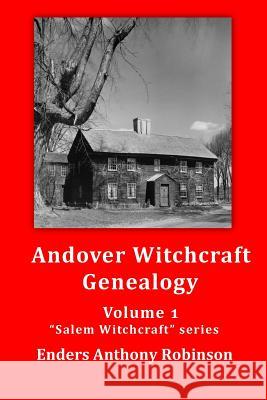Andover Witchcraft Genealogy: Volume 1 in the "Salem Witchcraft" series » książka
Andover Witchcraft Genealogy: Volume 1 in the "Salem Witchcraft" series
ISBN-13: 9781492909088 / Angielski / Miękka / 2013 / 214 str.
Andover Witchcraft Genealogy: Volume 1 in the "Salem Witchcraft" series
ISBN-13: 9781492909088 / Angielski / Miękka / 2013 / 214 str.
(netto: 33,63 VAT: 5%)
Najniższa cena z 30 dni: 35,11 zł
ok. 16-18 dni roboczych
Bez gwarancji dostawy przed świętami
Darmowa dostawa!
Millions of Americans have ancestors who were involved, in one way or another, in the Salem Witchcraft epidemic of 1692. There are even more people all over the world who have a natural curiosity and a general interest in specific aspects of the witchcraft affair. Genealogy can provide a doorway to the past, as it provides a means of looking into family connections and community relationships. It helps to break down figurative stone walls and clear up misty areas to get to hard facts. Knowledge of the specific features of the events that motivated the people in the witchcraft aberration can be a source of inspiration in the understanding of otherwise inexplicable events. The location of the witchcraft outbreak in February 1692 was Salem Village. Today it is known as the town of Danvers, a name chosen to cover up the past. This book is concerned with the phase of the Salem witch-hunt that spilled over into the neighboring town of Andover. This old town of Andover embraces the modern towns of North Andover and Andover. In a letter of October 8, 1692, THOMAS BRATTLE wrote, "This consulting of these afflicted children, about their sickness, was the unhappy beginning of the unhappy troubles at poor Andover. Poor Andover does now rue the day that ever the said afflicted went among them; they lament their folly, and are an object of great pity and commiseration." This book is based upon the common threads of birth, marriage, and death that all people share and understand when looking towards the past. In 1692, the condemned witches were put to death on Gallows Hill in Salem. It is a rocky hill on the outskirts of Salem Town. Scattered with the few oaks and locust trees that are able to take root in its shallow soil, the hill overlooks the Atlantic Ocean beyond. As if it were too great, too mighty for common benefits, the ocean has no compassion, no law, no memory, no faith. Its eternal nature is hidden in mystery.
Zawartość książki może nie spełniać oczekiwań – reklamacje nie obejmują treści, która mogła nie być redakcyjnie ani merytorycznie opracowana.











